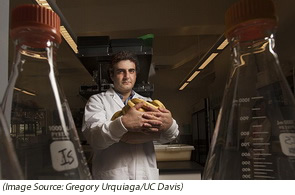
Banana Fungus DNA Unravelled; Findings to Lead to Hardier Bananas
August 17, 2016| |
 Researchers at the University of California Davis and Wageningen UR have unravelled the DNA of Pseudocercospora fijiensis, the fungus that causes black Sigatoka disease in bananas globally.
Researchers at the University of California Davis and Wageningen UR have unravelled the DNA of Pseudocercospora fijiensis, the fungus that causes black Sigatoka disease in bananas globally.
The Sigatoka complex's three fungal diseases — yellow Sigatoka (P. musae), eumusae leaf spot (P. eumusae) and black Sigatoka (P. figiensis) — emerged as destructive pathogens in the last century. Eumusae leaf spot and black Sigatoka are now the most devastating, with black Sigatoka posing the greatest constraint to banana production worldwide. Farmers need to apply fungicide at least 50 times per year to control the disease.
UC Davis plant pathologist Ioannis Stergiopoulos and colleagues sequenced the genomes of eumusae leaf spot and black Sigatoka, and compared their findings with the previously sequenced yellow Sigatoka genome sequence. They discovered that Sigatoka Complex has become lethal to banana plants not just by shutting down the plant's immune system, but also by adapting the metabolism of the fungi to match that of the host plants. As a result, the attacking fungi can produce enzymes that break down the plant's cell walls, allowing the fungi to feed on the plant's sugars and other carbohydrates.
For more details, read the news release at the UC Davis website.
| |
Biotech Updates is a weekly newsletter of ISAAA, a not-for-profit organization. It is distributed for free to over 22,000 subscribers worldwide to inform them about the key developments in biosciences, especially in biotechnology. Your support will help us in our mission to feed the world with knowledge. You can help by donating as little as $10.
-
See more articles:
-
News from Around the World
- Banana Fungus DNA Unravelled; Findings to Lead to Hardier Bananas
- Egyptian Students Organize Biotech Seminars for Sharing Knowledge
- Arctic® Fuji Apple Close to U.S. Regulatory Approval
- Capacity Building Sessions with Biosafety Regulators Held in Pakistan
- New Zealand EPA Declares Glyphosate as Noncarcinogenic
- Scientists Decode Major Pathogen of Barley
-
Research Highlights
- Researchers Engineer White Maize for Astaxanthin Production
- Isoamylase 1 Affects Starch Production and Amylopectin Structure in Durum Wheat Endosperm
-
Beyond Crop Biotech
- BplMYB46 Gene Affects Abiotic Stress Tolerance and Secondary Cell Wall Synthesis in Birch
- Researchers Sequence Tobacco Hornworm Genome
-
From the BICs
- Jordan Hosts Workshop on Plant Biotechnology and Biodiversity
-
Resources
- Biotech Country Facts and Trends
- TEDxUPM Talk on "GMOs: Seeds of Destruction?"
- World Seed Treatment Market Report
-
Plant
- Scientists Use Recombineering to Initiate Site-Directed Mutagenesis
-
Read the latest: - Biotech Updates (April 24, 2024)
- Gene Editing Supplement (April 24, 2024)
- Gene Drive Supplement (February 22, 2023)
-
Subscribe to BU: - Share
- Tweet
